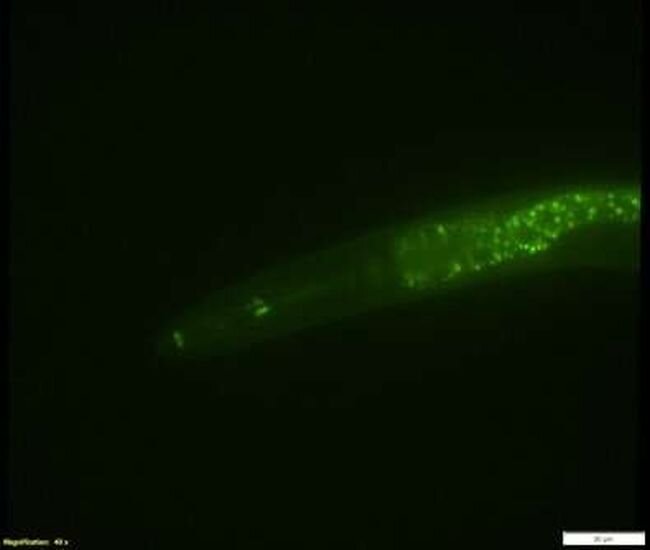November 26, 2025 | 19:01 GMT +7
November 26, 2025 | 19:01 GMT +7
Hotline: 0913.378.918
November 26, 2025 | 19:01 GMT +7
Hotline: 0913.378.918

Green fluorescent worm. Credit: University of Oregon
A new gene editing technique developed by University of Oregon (UO) researchers compresses what previously would have been years of work into just a few days, making new kinds of research possible in animal models. It'll allow biologists to do experiments that compare many versions of a gene, hunting for mutations that lead to specific traits and tracking their evolution over time.
Such research is often a first step towards identifying mutations that are relevant to human health, or in unraveling the mechanisms behind human diseases.
While mass gene editing tricks have been developed for single-celled organisms like bacteria and yeast, this is the first time it's been possible on this scale in an animal.
"In biology, we spend a lot of time working with genetic mutants. But in animals, we're limited by how many genetic mutants we can make at one time," says Zach Stevenson, a graduate student in Patrick Phillips' lab at UO who helped design the technique. "This is a way around that bottleneck."
Stevenson and his colleagues describe their new technique in a preprint posted to bioRxiv.
They've piloted the system in C. elegans, a tiny worm that's a popular species for biology research. A similar approach could eventually work in other lab animals, like flies or mice, Stevenson said.
"Genetic engineering the DNA of microbes has served as the basis of the revolution in biotechnology over the last three decades, but it has been difficult to do this at scale within animal systems," said Phillips. "The new approach developed in our lab can serve as a platform for a whole new way of using a simple animal as the basis for synthetic biology in the same way that bacteria and yeast have been used for a generation."
There are many reasons why scientists might want the ability to create many genetic mutations at once. For instance, they might be hunting for a mutation that could make an animal resistant to a specific drug, or better able to survive under certain conditions, or less susceptible to a disease. They might need to screen dozens or even hundreds of possible variations on a gene to find the one that's most effective.
These kinds of experiments are painstakingly slow in animals. Each mutant strain—a set of worms with a specific genetic modification—must be engineered individually. Making one mutant "usually takes between seven to ten hours of hands-on time," said Stevenson. Using this new system, "for the same labor of making three or four mutations, you can make tens of thousands."
To speed things up, Stevenson and his colleagues designed a way to compress hundreds or even thousands of possible mutations into a single "library." Each book in the library is a small snippet of genetic code, meaningless and non-functional on its own. Each snippet fits into an engineered gap in the gene that's being targeted, like a genetic Mad Libs puzzle.
This design means that instead of individually injecting many individual worms with different versions of a gene, researchers can inject the whole library of mutations into one worm.
Then, when the worm reproduces, the library expands. In each offspring, one book from the mutation library gets randomly selected to complete the gene being targeted. When a segment from the gene library slides in, it makes the gene active, like flipping a switch to complete an electrical circuit.
The result: a collection of worms that all have different randomly selected genetic mutations.
The researchers named their technique TARDIS—a playful nod to Dr. Who's space-and-time-traveling police box. Here, it stands for Transgenic Arrays Resulting in Diversity of Integrated Sequences. Like the fictional TARDIS, the worm "is bigger on the inside," Stevenson says. (That is, it contains a lot of extra genetic material.)
The researchers tested TARDIS with a gene that gives worms antibiotic resistance. But they see broad applications for biology in general, including research in other model organisms.
It could be especially useful for studying interactions between proteins or signaling between cells, suggests UO research professor Stephen Banse, who helped develop TARDIS. Such interactions are often relevant for understanding disease, but scientists lose important context by studying them in yeast or bacteria, Banse said. "Now we can do these things in an animal model."
(Phys)

(VAN) A new study reveals how the simultaneous effects of ocean acidification, salinity and loss of oxygen are making the world more fragile.

(VAN) Hopes are growing that the creation of the first 3D turkey gut model could be a turning point in the battle against the virulent blackhead disease.

(VAN) Tyson, America’s biggest meat supplier, plans to shutter one of its largest beef processing plants as the industry continues to struggle with low cattle supplies and political pressure from Washington.

(VAN) New FAO study shows how digital solutions are empowering farmers and fishers to prevent losses and build resilient agrifood systems.

(VAN) Brazil's COP30 presidency pushed through a compromise climate deal on Saturday that would boost finance for poor nations coping with global warming but that omitted any mention of the fossil fuels driving it.

(VAN) Poultry farmers in the UK have been warned that they could face one of the worst winters yet for bird flu.

(VAN) Prices of main-crop paddy have risen sharply, with jasmine rice hitting 16,100 baht per tonne — the highest level in years.